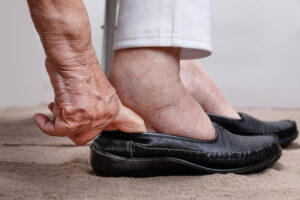Managing a foot health problem is no picnic. Whether its fallen arches that make walking uncomfortable or hyperhidrosis that makes your shoes stink beyond imagination, foot health problems are a hassle to deal with. Things are made worse when it is time to shop for new shoes. Finding comfortable shoes can be tough to say the least.
Most of what goes into comfort is related to how shoes fit. An improper fit can lead all sorts of issues, including:
- rubbing and chafing
- blisters and calluses
- sore feet and ankles
- excess of perspiration.
Fortunately, old-fashioned shoe stores that actually take the time to measure your feet still exist. You probably won’t get that kind of service at a department store, but you will get cheaper prices. You need to ask yourself which is more important to you. Do you want to spend a little more on shoes that fit well or save some money and take your chances?
Have Both Feet Measured
Speaking of having your feet measured, did you know that most people have feet of different sizes? It’s true. One foot is usually just a bit larger or smaller than the other. This makes a difference when you are measuring for shoes. Always fit your shoes to the larger foot. Also be sure to have your feet measured during the afternoon or evening hours.
It turns out that our feet tend to swell slightly as the day wears on. That means your feet will be their smallest size first thing in the morning. If you were to shop for shoes early in the day, you might end up with a pair that is too tight by the end of the day. Throw in foot health problems, and it is practically inevitable your shoes will not be comfortable. So your best bet is to shop as late in the day as you can.
Make Room for the Socks
Unless you are buying sandals or flip-flops, don’t forget to leave room for the socks. New shoes should be loose enough to accommodate socks but not so loose that they cause friction around the ankles or toes. As for your socks, they are an important tool for absorbing perspiration and providing a barrier between your skin and the inner surface of your shoes.
Incidentally, spending a bit more on high quality socks could make a difference if you suffer from hyperhidrosis. Highly absorbent socks draw perspiration away from your skin and hold it. If they manage to keep most of the perspiration out of the shoe material, socks should also cut down on shoe odors.
Fitting the Shoes
One final recommendation is that you fit your shoes based on three principles. First, get up and walk around. The shoes should fit comfortably and with little to no friction around the ankles and toes. Second, the shoe should not be too tight around the sides and across the top. Third, there should be a quarter to half inch of space between the tip of your longest toe and the end of the shoe.
While you are shopping for new shoes, don’t forget to pick up a good shoe spray for foot odor. We obviously recommend ShoeFresh deodorizing spray. Our spray eliminates odors and prevents them from returning for up to three months. Whether you choose ShoeFresh or not, a deodorizing spray should help prevent or completely eliminate stinky shoes.
Buying new shoes can be tough when you suffer from foot help problems. Just remember that shoe comfort is usually about fit. Have your feet measured by a professional, then fit your shoes according to those measurements. You should find that you are more comfortable as a result.
